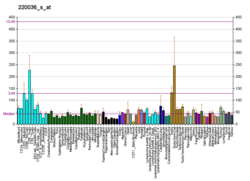| LMBR1L |
|---|
|
| Identifiers |
|---|
| Aliases | LMBR1L, LIMR, limb development membrane protein 1 like |
|---|
| External IDs | OMIM: 610007; MGI: 1289247; HomoloGene: 10011; GeneCards: LMBR1L; OMA:LMBR1L - orthologs |
|---|
| Gene location (Human) |
|---|
 | | Chr. | Chromosome 12 (human)[1] |
|---|
| | Band | 12q13.12 | Start | 49,097,136 bp[1] |
|---|
| End | 49,110,900 bp[1] |
|---|
|
| Gene location (Mouse) |
|---|
 | | Chr. | Chromosome 15 (mouse)[2] |
|---|
| | Band | 15 F1|15 55.1 cM | Start | 98,801,798 bp[2] |
|---|
| End | 98,816,112 bp[2] |
|---|
|
| RNA expression pattern |
|---|
| Bgee | | Human | Mouse (ortholog) |
|---|
| Top expressed in | - right testis
- left testis
- right uterine tube
- anterior pituitary
- left ovary
- gastric mucosa
- body of uterus
- tibial nerve
- right hemisphere of cerebellum
- right ovary
|
| | Top expressed in | - neural layer of retina
- granulocyte
- spermatid
- spermatocyte
- lip
- yolk sac
- seminiferous tubule
- thymus
- ventricular zone
- tail of embryo
|
| | More reference expression data |
|
|---|
| BioGPS |  | | More reference expression data |
|
|---|
|
| Gene ontology |
|---|
| Molecular function | - protein binding
- transmembrane signaling receptor activity
| | Cellular component | - membrane
- integral component of membrane
- plasma membrane
- integral component of plasma membrane
| | Biological process | - endocytosis
- receptor-mediated endocytosis
- signal transduction
| | Sources:Amigo / QuickGO |
|
| Orthologs |
|---|
| Species | Human | Mouse |
|---|
| Entrez | | |
|---|
| Ensembl | | |
|---|
| UniProt | | |
|---|
| RefSeq (mRNA) | NM_001300750
NM_001300751
NM_018113
NM_001352161
NM_001352162
|
|---|
NM_001352163
NM_001352164
NM_001352165
NM_001352166
NM_001352167
NM_001352168 |
| |
|---|
| RefSeq (protein) | NP_001287679
NP_001287680
NP_060583
NP_001339090
NP_001339091
|
|---|
NP_001339092
NP_001339093
NP_001339094
NP_001339095
NP_001339096
NP_001339097 |
| |
|---|
| Location (UCSC) | Chr 12: 49.1 – 49.11 Mb | Chr 15: 98.8 – 98.82 Mb |
|---|
| PubMed search | [3] | [4] |
|---|
|
| Wikidata |
| View/Edit Human | View/Edit Mouse |
|
















